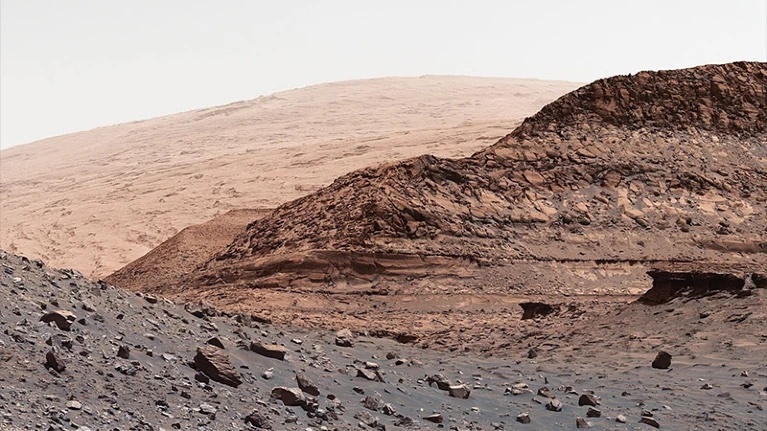15.11.2023
The system uses Martian materials to produce catalysts that release oxygen from water.

A close-up of Martian rocks in Paraitepuy Pass taken by NASA’s Curiosity rover.Credit: NASA/JPL-Caltech/MSSS
Researchers in China have developed a robot chemist powered by artificial intelligence (AI) that might be able to extract oxygen from water on Mars. The robot uses materials found on the red planet to produce catalysts that break down water, releasing oxygen. The idea could complement existing oxygen-generating technologies or lead to the development of other catalysts able to synthesize useful resources on Mars.
“If you think about the challenge of going to Mars, you have to work with local materials,” says Andy Cooper, a chemist at the University of Liverpool, UK. “So I can see the logic behind it.”
The study, published in Nature Synthesis1, was led by Jun Jiang at the University of Science and Technology of China in Hefei. Jiang and his team used a mobile machine the size of a refrigerator with a robotic arm to analyse five meteorites that had either come from Mars or been collected on Earth but mimicked the Martian surface. The team’s goal was to investigate whether the machine could produce useful catalysts from the material.
The AI-powered system used acid and alkali to dissolve and separate the material, then analysed the resulting compounds. These then formed the basis of a search of more than 3.7 million formulae for a chemical that could break down water — known to exist as ice at Mars’ poles and under the planet’s surface — a process the team said would have taken a human researcher 2,000 years. The result was an oxygen-evolution reaction catalyst that could release oxygen from water, with the potential for use on a future Mars mission.
“We have developed a robotic AI system that has a chemistry brain,” says Jiang. “We think our machine can make use of compounds in Martian ores without human guidance.”
Catalytic creator
If a catalyst that can produce oxygen from water can be made on Mars, this would remove the need for missions to carry such a catalyst from Earth. Jiang says that for every square metre of Martian material, his group’s system could make nearly 60 grams of oxygen per hour, potentially removing the need for astronauts on future missions to the planet to carry oxygen from Earth to use when they get there. “The robot can work continuously for years,” says Jiang.
However, Michael Hecht at the Massachusetts Institute of Technology’s Haystack Observatory in Westford says that there is a much easier way to produce oxygen on Mars. He is the lead investigator on the Mars Oxygen In-Situ Resource Utilization Experiment (MOXIE) on board NASA’s Perseverance rover, which touched down on Mars in February 2021, and has successfully demonstrated the production of oxygen from the Martian air, which is mostly carbon dioxide.
MOXIE has only been used to produce a few grams of oxygen at a time, owing to the modest power output of Perseverance. But in future, a scaled-up version of MOXIE could be used to produce more than enough oxygen for a human settlement. MOXIE could also produce a sufficient quantity of the gas to serve as the oxidizer for rocket fuel to launch a craft for a return trip to Earth. “You can produce two to three kilograms an hour,” says Hecht. “There’s zero obstacle to scaling this up.”
Jiang points out that his group’s robotic chemist could also be used to produce other useful catalysts on Mars, for processes such as fertilizing plants. “Different chemicals can be made by this robot,” he says. And Mars isn’t the only place where it could have uses. “Maybe lunar soil is another direction,” Jiang says.
Using AI to synthesize useful materials in this way is a novel area of research, says Cooper, that has applications beyond space travel. “It’s an emerging method of using AI that’s more broadly applicable to all kinds of chemistry, not just to catalysis and oxygen production,” he says.
Quelle: nature

